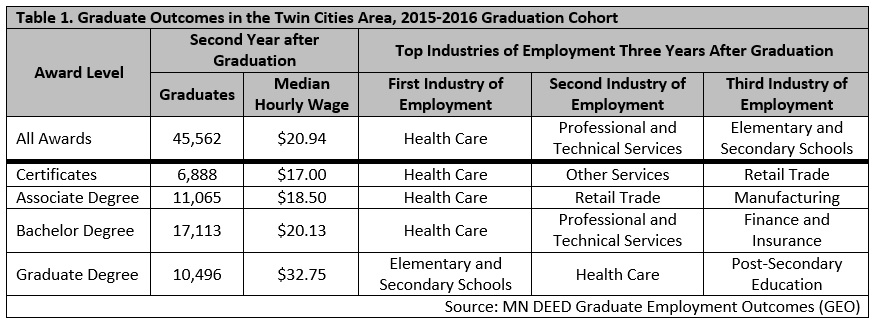 The Minneapolis-St. Paul metropolitan area is a national leader in finance, advanced manufacturing, agriculture and retailing.
The Minneapolis-St. Paul metropolitan area is a national leader in finance, advanced manufacturing, agriculture and retailing.
Medical devices, electronics and processed foods are strong suits recognized globally.
Want the freshest data delivered by email? Subscribe to our regional newsletters.
4/11/2019 3:00:00 PM
Tim O'Neill
The Metro Area Local Look blog last highlighted the Graduate Employment Outcomes tool back in 2017. At that time, GEO data was updated through the 2014 graduation cohort. With recent updates, GEO data now includes up through the 2016 graduation cohort.
If you missed the Graduate Employment Outcomes in the Twin Cities blogpost, or missed out on the GEO tool entirely, you’re in for a treat. The GEO tool shows how graduates from educational institutions in Minnesota are doing in the labor market two, three, five, and eight years after completing their respective programs. Users of the tool can filter their search of graduate outcomes by graduation year (2006 through 2016), school location (statewide, Twin Cities Area, and Greater Minnesota), award type (certificates, associate degree, bachelor’s degree, and graduate degree), institution type (both private and public institutions), specific school, and instructional program. Lots of options to choose from!
Users will be able to analyze the following for completer data:
That last bullet point brings up an important limitation to the GEO tool: Outcomes represent only the graduates who worked in Minnesota as identified in the state’s Unemployment Insurance wage records. Although about 95 percent of Minnesota’s businesses report wages, people employed by federal agencies, people who are self-employed, or people employed in other states are excluded.
The workforce and education data within the GEO tool are collected through a collaboration of DEED and the Minnesota Office of Higher Education (OHE). Learn more about the tool here.
The 2016 graduation cohort in the Twin Cities Area was 45,562 completers strong. Just over 15 percent of these graduates completed a certificate; over 24 percent completed an associate degree; nearly 38 percent completed a bachelor’s degree; and the remaining 23 percent completed a graduate degree. Two years after completing any type of award, graduates from educational institutions in the Twin Cities were earning a median hourly wage of $20.94. Wages climbed for each higher level of educational attainment, reaching a median hourly wage of $32.75 for graduate degree completers (Table 1).
While wages did go up with higher levels of educational attainment, programs of study also had a definitive impact upon earnings. For example, obtaining an associate degree in registered nursing resulted in median earnings of $31.43 per hour two years after graduation. Similarly, completing a certificate in plumbing and related water supply services resulted in median earnings of $44.64 per hour. In contrast, graduates with bachelor’s degrees in history were earning a median wage of $15.05 per hour, with the largest number of jobs found in retail trade; and graduates with bachelor’s degrees in radio, television, and digital communication reported a median hourly wage of $14.78.
Clearly, choice of major matters in labor market outcomes. Students, career seekers, and others interested in furthering their education can use the GEO data to make more-informed decisions on their educational pathways. While past graduate outcomes cannot predict the market success of future graduates, and success is measured by more than just wages, users of the GEO tool can get a better sense of perception and reality for numerous educational pathways.

Contact Tim O’Neill at 651-259-7401.